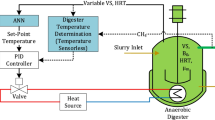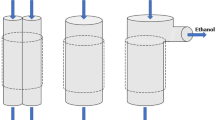Abstract
In glutamate fermentation, intermittent feeding is the most widely used glucose feed strategy. This feeding strategy causes severe fluctuations of glucose concentration and osmotic pressure in fermentation broth, which deteriorates the viability of the cell and reduces glutamate production in turn. In order to maintain glucose concentration at stable and constant levels, an on-line prediction and feedback control system based an empiric mass balance model was developed. However, the control system did not work properly and sometimes glucose concentration could even decline to 0 level (glucose exhaustion), as the model parameter varies in different runs. As a result, a novel model-based adaptive feedback control system incoporating with an artificial neural network (ANN) based pattern reconition unit for on-line diagnosizing the fault of glucose exhaustion was proposed and applied for glutamate fermentation. This adaptive control system could accurately detect glucose exhaustion when it occurs, and then immediately updates the control parameter based on some pre-defined rule. With the proposed control system, glucose was automatically fed, and its concentration could be maintained at desired levels constantly. As a result, glutamate concentration was 17 ~ 30% higher than that of the traditional fermentations using the intermittent glucose feed strategy.
Similar content being viewed by others
References
Sano, C. (2009) History of glutamate production. Amer. J. Clin. Nutr. 90: 728S-732S.
Xiao, J., Z. P. Shi, P. Gao, H. J. Feng, Z. Y. Duan, and Z. G. Mao (2006) On-line optimization of glutamate production based on balanced metabolic control by RQ. Bioproc. Biosyst. Eng. 29: 109–117.
Gourdon, P. (2003) Osmotic stress, glucose transport capacity and consequences for glutamate overproduction in Corynebacterium glutamicum. J. Biotechnol. 104: 77–85.
Heller, A. and B. Feldman (2008) Electrochemical glucose sensors and their applications in diabetes management. Chem. Rev. 108: 2482–2505.
Jin, H., X. Chen, L. Wang, K. Yang, and L. Wu (2015) Adaptive soft sensor development based on online ensemble gaussian process regression for nonlinear time-varying batch processes. Ind. Eng. Chem. Res. 54: 7320–7345.
Zhu, J., Z. Ge, and Z. Song (2015) Robust semi-supervised mixture probabilistic principal component regression model development and application to soft sensors. J. Proc. Control. 32: 25–37.
Gustavsson, R., C. Lukasser, and C.-F. Mandenius (2015) Control of specific carbon dioxide production in a fed-batch culture producing recombinant protein using a soft sensor. J. Biotechnol. 200: 44–51.
Agatonovic-Kustrin, S. and R. Beresford (2000) Basic concepts of artificial neural network (ANN) modeling and its application in pharmaceutical research. J. Pharmaceut. Biomed. Anal. 22: 717–727.
Jin, H., Z. Zheng, M. Gao, Z. Duan, Z. Shi, Z. Wang, and J. Jin (2007) Effective induction of phytase in Pichia pastoris fedbatch culture using an ANN pattern recognition model-based online adaptive control strategy. Biochem. Eng. J. 37: 26–33.
Ardehali, M. M., M. Farmad, and C. C. Adams (2010) Development of pattern recognition based ANN for energy auditing and inefficiency diagnostics of influential design elements utilising electrical energy data. J. Energy Inst. 83: 101–107.
Chinas, P., I. Lopez, J. A. Vazquez, R. Osorio, and G. Lefranc (2015) SVM and ANN Application to Multivariate Pattern Recognition Using Scatter Data. IEEE Lat. Amer. Trans. 13: 1633–1639.
Zhang, C., Z. Shi, P. Gao, Z. Duan, and Z. Mao (2005) On-line prediction of products concentrations in glutamate fermentation using metabolic network model and linear programming. Biochem. Eng. J. 25: 99–108.
Author information
Authors and Affiliations
Corresponding authors
Rights and permissions
About this article
Cite this article
Ding, J., Jia, L., Mpofu, E. et al. An on-line adaptive glucose feeding system incorporating patterns recognition for glucose concentration control in glutamate fermentations. Biotechnol Bioproc E 21, 758–766 (2016). https://doi.org/10.1007/s12257-016-0394-z
Received:
Revised:
Accepted:
Published:
Issue Date:
DOI: https://doi.org/10.1007/s12257-016-0394-z




